
OneHundredCoffee is reader-supported, and some products displayed may earn us an affiliate commission. Details
The morning I finally took my coffee ritual seriously, my entire workday changed. I used to shuffle to the kitchen half-asleep, hit a random brew button, scroll my phone, and hope focus would find me. It rarely did. What finally made the difference wasn’t some secret bean from a hidden farm; it was a handful of small, repeatable habits around coffee—timing, setup, and intention—that turned those first sips into a daily launch sequence. If you’ve ever wondered how to brew better coffee and better mornings, this is a friendly, convenient guide you can put to work tomorrow.
Why Your Morning Coffee Routine Matters More Than You Think
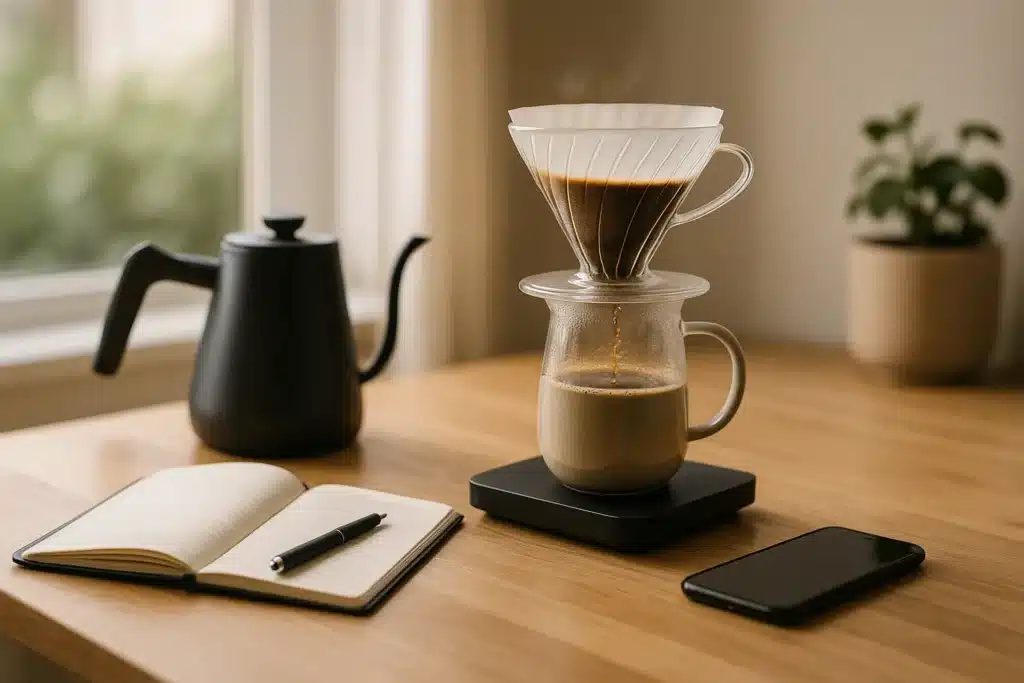
Coffee by itself is just a beverage. Coffee as a routine is a trigger, a transition, and a promise. The smell of fresh grounds, the sound of water hitting a bed of coffee, the first warm sip—these are tiny cues that tell your brain it’s time to switch on. When the ritual is consistent, it becomes a steady anchor in the chaotic swirl of morning distractions. The cup is the reward, but the sequence—prep, brew, sip, focus—is the habit loop that makes productivity predictable.
Here’s the simple truth I learned the hard way: your morning doesn’t need more intensity; it needs fewer decisions. When the coffee routine is dialed, you remove friction, set a steady tempo, and create a dependable doorway into your first deep-work block. That’s where the day is won.
The Timing Trick: Drink Coffee When It Works With Your Brain
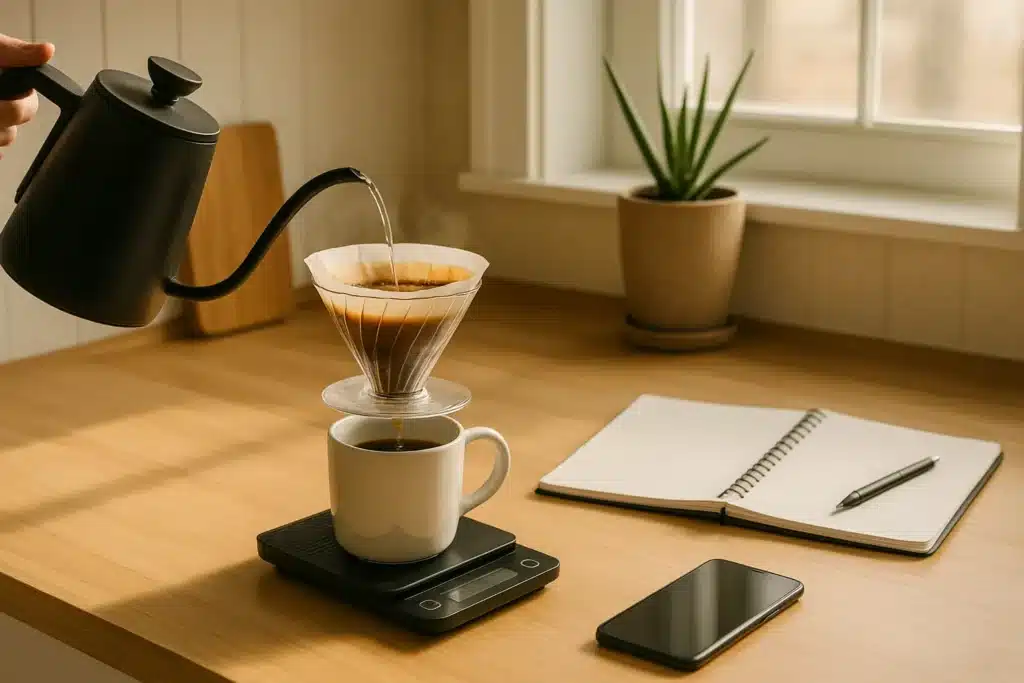
There’s a sweet spot for caffeine. For many people, that’s not the exact second you crawl out of bed. I’ve had the best results waiting a little after waking—long enough to hydrate and move around—then brewing when my mind is ready to lock on. That slight delay seems to kickstart focus without the jittery dip that can happen when you chase alertness too early.
A gentle morning rhythm looks like this: wake up, drink a glass of water, step outside or stretch for a minute or two, then make your coffee. Those small minutes soften the edges of grogginess and help your body meet the caffeine halfway. It’s not about strict rules; it’s about finding a window that consistently delivers calm energy rather than a spike-and-crash.
If you’re a very early riser or a parent whose mornings are a sprint, your timing might simply be “whenever you can.” That’s fine. Pair coffee with one specific action—opening your notebook, launching your task list, or starting a time-block timer—and the pairing becomes your productivity switch.
Choose the Brew Method That Fits Your Morning Bandwidth
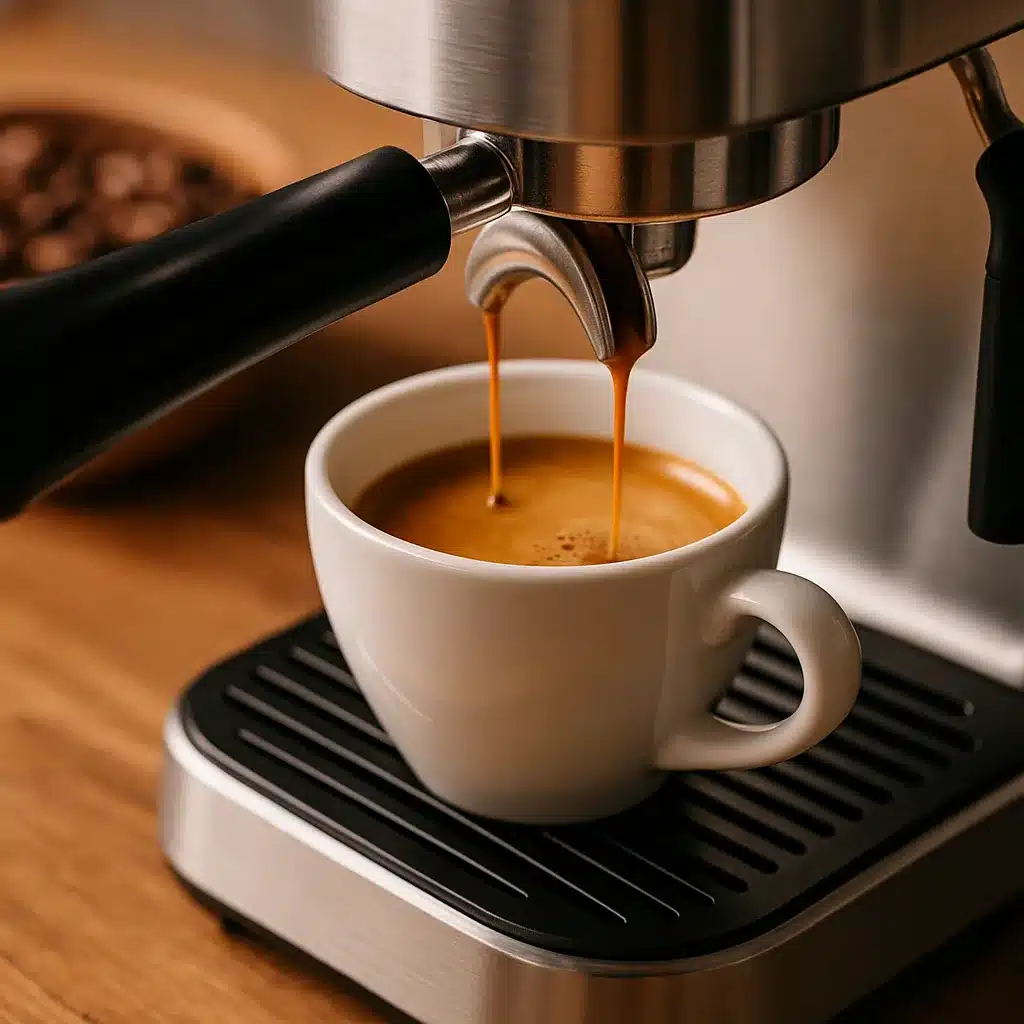
Some mornings are handbrew-and-meditation mornings. Others are “I have a 7:45 meeting and one brain cell” mornings. Let your brew method match your bandwidth.
Espresso (fast and focused): If you keep a small machine on your counter, espresso is your two-minute ticket to a concentrated start. The routine can be surprisingly quick once your grind and dose are set. I treat it like a mantra: dose, tamp, pull, sip, plan.
Drip coffee maker (set-and-go): For hands-off convenience with great flavor, a quality drip brewer is a weekday hero. Set your water, dose, and filter the night before. In the morning, hit brew and use those minutes to warm up your brain—journal, a short walk, or a quick email triage—then pour and get to work.
Pour-over (calm and precise): V60, Kalita, or Chemex reward attention with clarity. When I want a clean cup and a mindful start, I stand by the kettle, watch the bloom, and feel my thoughts line up. The process becomes meditation that happens to produce excellent coffee.
AeroPress or immersion (travel-friendly and forgiving): The AeroPress is the Swiss Army knife of morning routines—quick, versatile, and consistent. French press is another cozy option: easy to set, easy to sip, and great for lingering over a page of reading before you dive into your day.
Capsule machines (reliable speed): When time is tight, predictability matters. If capsules save you from skipping breakfast and doomscrolling, they’re doing their job. Keep the rest of your routine tidy and intentional, and let convenience work for you.
There is no single “best” method. The best is the one you’ll actually use every day. Consistency beats perfection.
Prep the Night Before: Make Morning Frictionless
Night-me takes care of morning-me. That’s the rule. I line up the kettle, scale, brewer, filter, and mug. I fill the kettle with fresh water and confirm I have enough beans for tomorrow’s dose. If I’m using a drip machine, I set the filter and dose the grounds in a sealed container so I can just pour and press start. The entire setup takes three quiet minutes before bed and saves me from seven sleepy decisions in the morning. Those minutes compound into a calmer day.
If you grind fresh in the morning (you should!), leave the grinder hopper empty and weigh your beans the night before. You’ll be surprised how much smoother the first 10 minutes feel with zero rummaging.
Brew Ratios and Repeatability (So Your Tasty Cup Is Predictable)
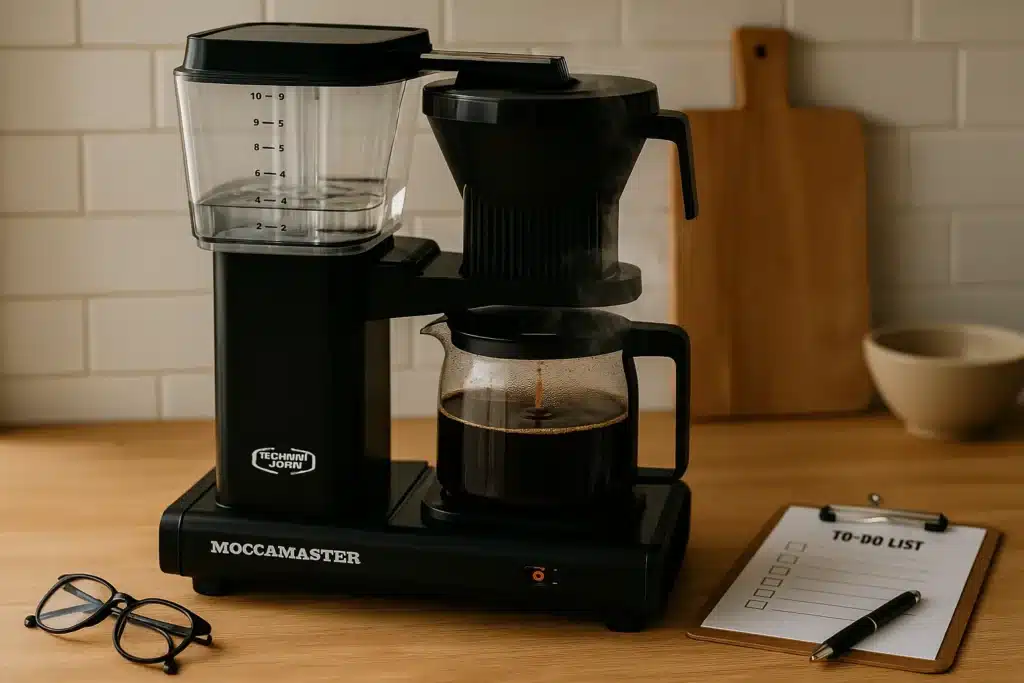
The fastest way to go from “eh” to “consistently great” is to use a simple brew ratio and stick to it. Measure your coffee and water. That’s it.
- Filter coffee often sings between 1:15 and 1:17 (1 gram coffee to 15–17 grams water). I like 22 g coffee to 360 g water for a tidy, one-mug pour-over.
- French press is forgiving at 1:15. If you want more heft, edge toward 1:14.
- AeroPress loves experimentation; start around 1:12 for a concentrated brew, then top with hot water to taste.
- Espresso is usually 1:2 (e.g., 18 g in, 36 g out) in about 25–30 seconds, but your machine and beans will nudge that slightly.
Write your favorite combos on a sticky note. When you open a new bag, start with your baseline and adjust one variable at a time: grind, ratio, or temperature. You’ll dial in faster and save your patience for work that actually pays the bills.
A Three-Recipe Toolkit for Real-Life Mornings
The 5-Minute Sprint (AeroPress, inverted or classic)
Grind slightly finer than drip. Use about 16–18 g of coffee to ~200 g of water. Bloom briefly, stir, steep a minute, then press slowly. Top up with hot water if you want a longer cup. It’s quick, punchy, and surprisingly sweet for how little time it takes.
The 10-Minute Sweet Spot (V60 or Kalita)
Grind medium. Try 22 g of coffee to 360 g of water. Bloom with 60 g for 30–40 seconds, then pour in two or three steady pulses to keep the bed flat. Aim for a 2:30–3:00 total brew. Expect a clean, focused cup that plays well with to-do lists.
The 15-Minute Slow & Steady (French Press)
Grind medium-coarse. Use 30 g of coffee to 450 g of water. Pour, stir gently, steep four minutes, skim the surface, then press and decant fully. The body is cozy without muddiness, perfect for days when you want to think big and work steadily.
Pair Your Cup With a Single Intent
Here’s the habit that changed my output: I only take the first sip when my first task is open on-screen or on paper. Coffee is no longer background; it’s the starter pistol. Sometimes that’s drafting a tough paragraph. Sometimes it’s outlining three priorities for the next two hours. In either case, coffee becomes the bridge from waking to doing, not a fuzzy detour I scroll through.
Try a “no-scroll sip” rule: no social media or inbox until you’ve finished your first cup and completed one meaningful, 10–20 minute task. That early win sets the tone for the day.
Hydrate, Then Caffeinate (Your Brain Notices)
A glass of water before coffee feels boring until you try it for a week and realize your brain lights up faster with fewer jitters. I keep a glass by the kettle and make it part of the ritual—water while the kettle heats, then coffee. It’s a tiny investment in smoother focus.
If you’re sensitive to coffee on an empty stomach, add a small snack—yogurt, a banana, or a slice of toast with peanut butter. You’ll feel the lift without the edge.
The Second-Cup Strategy (And Why It Matters)
Your second cup should be a plan, not a reflex. Mid-morning is prime time for a gentle top-up, especially if your day has a natural second sprint. I aim for a smaller second cup—half a pour-over or a quick lungo—right before I start the next focused block. Pair it with a stretch and a quick reset of your desk. The goal is to keep energy even rather than chasing spikes.
If afternoon sleep is sacred to you, cut caffeine around early afternoon. You’ll fall asleep faster, and the next morning will start stronger. Think of your second cup as fueling momentum, not patching burnout.
“Coffee Naps” Actually Work (If You Keep Them Short)
The trick is simple: drink a small coffee quickly, then lie down for 15–20 minutes. Caffeine takes a little while to kick in, and a brief nap clears some fog just as your coffee ramps up. You’ll bounce back sharper than either coffee or a nap alone. I use this on heavy writing days when I want to protect my afternoon from turning into molasses.
Work-From-Home vs. Office Mornings
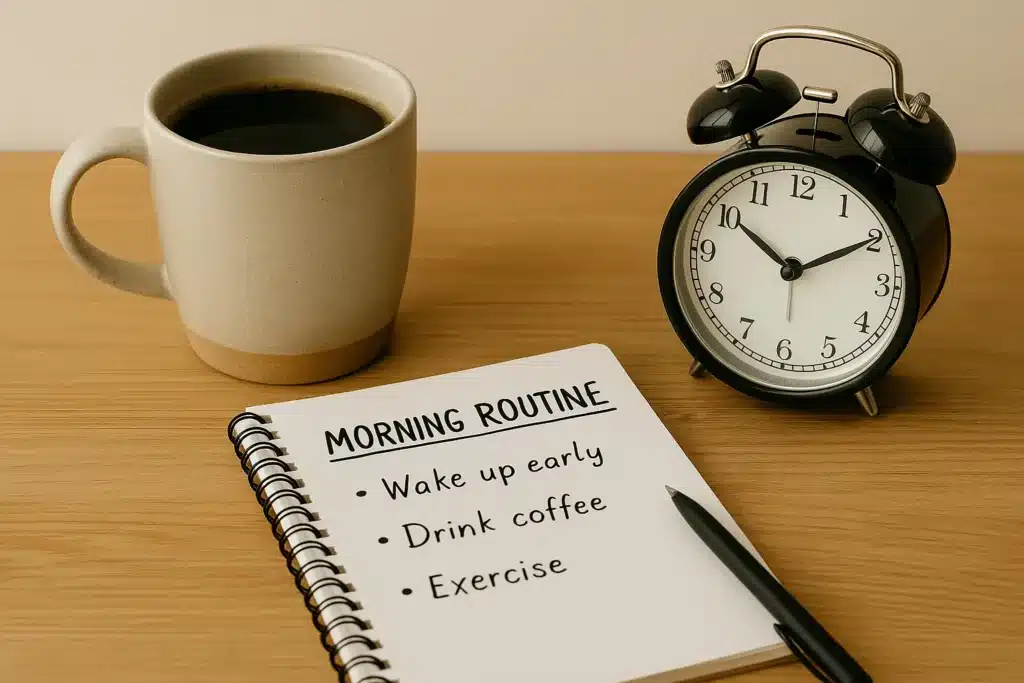
At home, you can design the entire environment—quiet, light, music, the mug you love. In the office, the actual brewing may be out of your control, but the habit is still yours. Keep a small kit: a high-quality travel mug, a few single-serve filter packs or a compact dripper, and a notebook. If the office coffee is average, the ritual of sitting with a warm mug and a single clear task still flips your brain into work mode. The gear is optional; the sequence is everything.
Maintenance: The Productivity You Don’t See
A clean grinder and brewer are the quiet backbone of good mornings. Old oils and residue deaden flavor, and you end up chasing better beans when you really need a rinse and a brush. Every few days, give your gear a quick clean. Once a week, do a deeper wash of the carafe, dripper, and baskets. If you’re an espresso person, backflush and keep the steam wand spotless. Your coffee—and your mood—will thank you.
Beans That Behave on Busy Mornings
I love wild, fruit-forward coffees on relaxed weekends, but on back-to-back meeting days, I reach for beans that are dependable: medium roasts that deliver chocolate, caramel, and a touch of citrus without demanding a perfect pour. If your mornings are chaotic, choose beans with a sweet spot that’s easy to find. When you want to experiment, save it for the weekend; your Wednesday 8 a.m. doesn’t need drama.
Store your beans airtight, away from heat and light. If it takes you weeks to finish a bag, freeze it in small portions. Grind straight from frozen and keep your brewing routine unchanged. Consistency is your ally.
Taste and Adjust: A Friendly Troubleshooting Guide
If your cup tastes sour or thin, grind a little finer or brew a touch longer. If it’s bitter or flat, grind slightly coarser or drop your water temperature a couple of degrees. If it’s weak, add a gram or two of coffee at the same water volume. Keep notes; your palate gets smarter the more you listen to it.
And if you think water can’t be the problem, try brewing with filtered water for a few days. Many “meh” mornings are actually “tap water being tap water.” When the water is right, your modest setup can taste surprisingly premium.
The Intention Sandwich: How I Turn Coffee Into Action
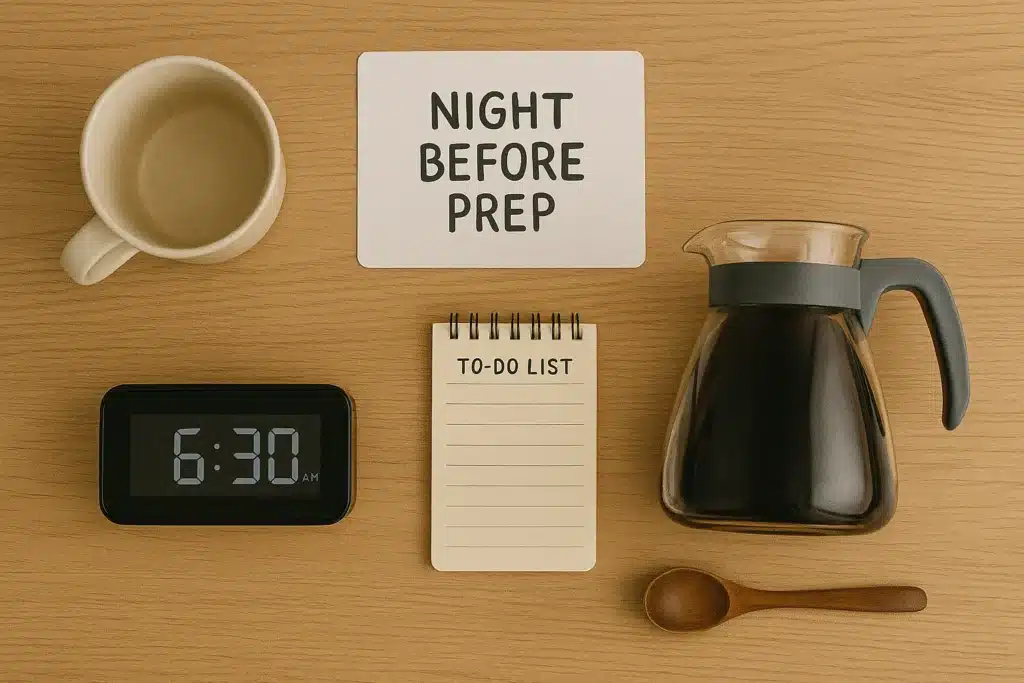
I set the kettle and open my notebook. While the water heats, I write three bullets: the one outcome that would make today a win, one chore I’ll stop stressing about until later, and one person I’ll help. Then I brew. The first sip marks the first sentence on the task that matters most. When the cup is empty, I’ve usually passed the hardest part of the day—the start. It feels ordinary, but it’s quietly powerful. That’s what a good coffee habit does: it makes the hard part feel doable.
Weekend Practice, Weekday Payoff
Weekends are your lab. Try a new method, dial in a new grinder setting, or explore a different origin. Learn how your gear behaves when you’re not racing the clock. The confidence you build on Saturday morning becomes speed and calm on Monday. Coffee knowledge doesn’t need to be fussy; it just needs to be yours.
Best 5 Morning Coffee Gear Picks (Available on Amazon)
These are dependable workhorses that make weekday brewing simpler, faster, and more consistent. I’ve favored gear that balances quality with ease—perfect for routines you’ll actually keep.
Breville Bambino Plus
Fast heat-up, simple workflow, and capable milk steaming in a compact footprint. Ideal if you want café-style espresso without turning your kitchen into a lab.

Who is this for?
The Breville Bambino Plus is for coffee lovers who want barista-quality espresso at home with minimal fuss. It heats up in just 3 seconds and features automatic milk frothing. Ideal for beginners or small kitchens, it combines speed, performance, and compact elegance in one sleek stainless-steel machine.Technivorm Moccamaster KBGV Select
A gold-standard drip brewer that’s remarkably consistent and quick. Great for set-and-go mornings when you want a clean, flavorful carafe waiting while you map your day.
Who is this for?
The Moccamaster KBGV Select is ideal for coffee purists seeking consistent, flavorful brews. With a 10-cup capacity, copper heating element, and elegant design, it’s perfect for home brewers who appreciate quality craftsmanship and precision. It’s especially suited for those who value fast brewing with no compromise on taste or temperature.OXO Brew 8-Cup Coffee Maker
Thoughtful design, certified brewing temperatures, and a smaller footprint. It handles single cups and full carafes equally well, which makes it flexible for solo mornings or the whole household.
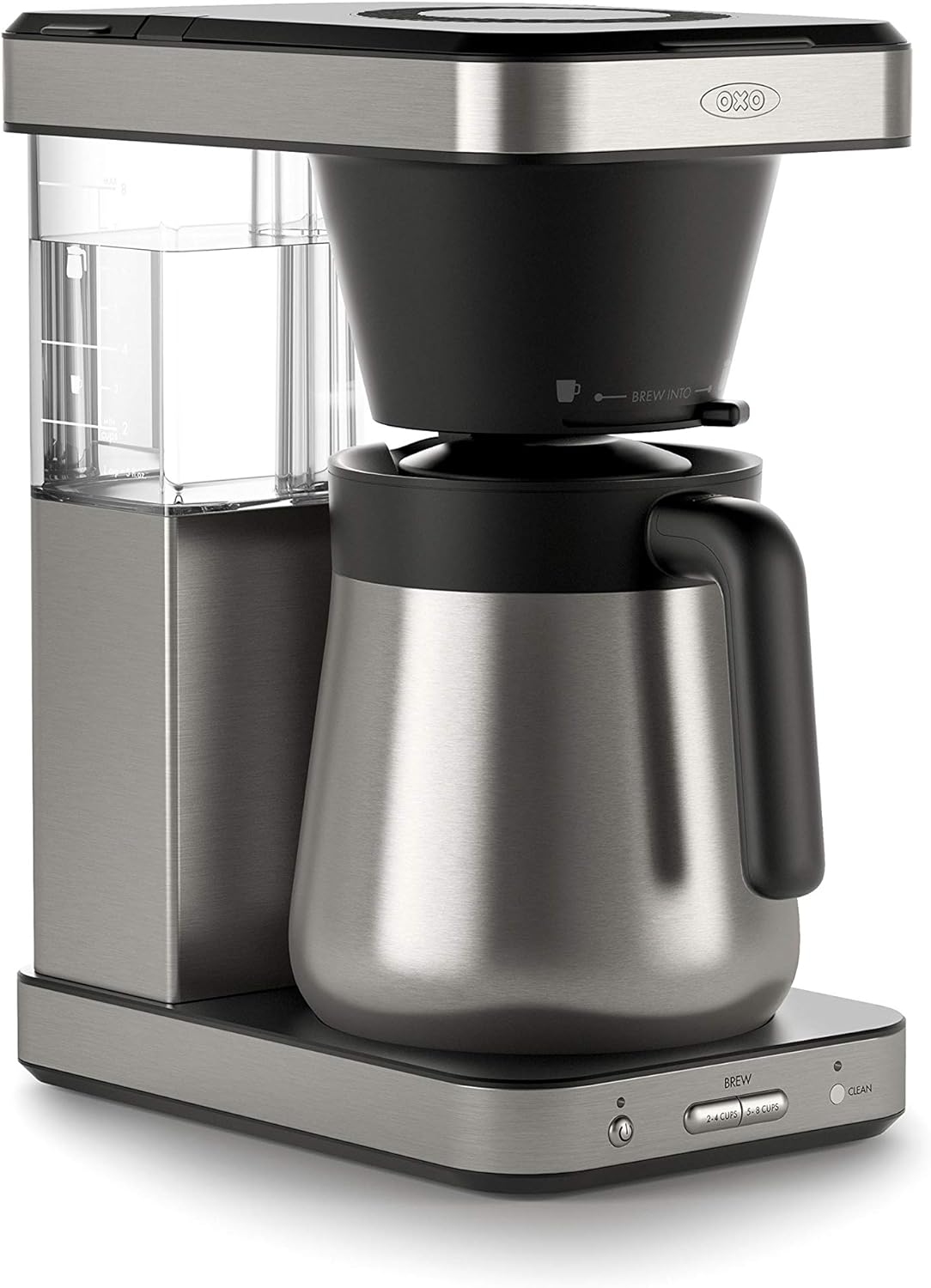
Who is this for?
The OXO Brew 8-Cup Coffee Maker is perfect for those who value precision, convenience, and quality. Whether you’re brewing a single mug or a full carafe, it delivers Gold-standard SCA-certified coffee with rainmaker technology and thermal carafe. Ideal for home baristas wanting a compact yet professional coffee-making experience.Fellow Stagg EKG Electric Kettle
Precise temperature control and a spout that pours exactly where you want. If you enjoy pour-over or AeroPress, this kettle turns precision into a relaxed, repeatable motion.
Who is this for?
The Fellow Stagg EKG is ideal for pour-over enthusiasts and design-conscious brewers. With precise temperature control, a sleek minimalist design, and an ergonomic gooseneck spout, it’s perfect for anyone serious about precision brewing. Whether beginner or barista, this kettle enhances every morning ritual with form and function.A 7-Day “Brew Better Mornings” Plan
Day 1: Make space. Clear a small square of the counter just for coffee. Put your kettle, brewer, and mug there. Neatly. Your eyes will say, “This is easy.”
Day 2: Set your baseline. Choose one ratio and stick to it. For pour-over, try 22 g of coffee to 360 g of water. Write it down and use it all week.
Day 3: Add the no-scroll sip. Do not open social feeds until you’ve finished your first cup and completed one meaningful 10-minute task. Enjoy the quiet win.
Day 4: Night-me helps morning-me. Prep the station before bed. Weigh your beans. Fill the kettle. Place your filter. Morning will feel lighter.
Day 5: Pair the cup with a mission. Start brewing after you’ve chosen one must-do task. The first sip = first step.
Day 6: Fix one small thing. If your cup has been “fine,” improve one variable—grind a touch finer or coarser, or try filtered water. Notice the difference.
Day 7: Celebrate with curiosity. Brew a second method or a different origin. Take notes on how it changes your mood and focus. Keep what works; drop what doesn’t.
Repeat the cycle next week with minor tweaks. By the third week, your morning coffee won’t just taste better—it will be your productivity system.
When Life Gets Messy, Keep the Ritual Tiny
There will be mornings that laugh at your plans. Sleep was short, the schedule is packed, and your patience is squeaky. Shrink the ritual instead of skipping it. A capsule, a quick kettle pour over an unfussy dripper, or even a simple instant coffee upgraded with hot water at the right temperature can still carry the signal: sit, sip, start. The point isn’t perfection; it’s continuity.
Friendly Reminders You’ll Be Glad You Followed
- Choose the method you can perform half-asleep and still enjoy.
- Measure (roughly is better than guessing), then adjust one thing at a time.
- Drink water first. Your brain likes it, your cup tastes better, and your mood will prove it.
- Pair that first sip with one meaningful action. You’ll redefine “morning person” on your own terms.
- Treat weekends like your playground; let weekdays be your routine.
The Last Sip
A good cup is fuel. A good habit is a compass. Morning coffee habits that work aren’t glamorous; they’re gentle and repeatable—so obvious when you look back that you wonder why you didn’t do them sooner. Brew in a way that respects your bandwidth. Let your routine unfold at a human pace. Then, take that first sip and begin—decisively, calmly, and with the kind of focus that makes the rest of the day feel lighter.








